Social Justice and Leadership Practices in Early Childhood Education
VerifiedAdded on 2019/10/31
|9
|3532
|31
Report
AI Summary
This report delves into the significance of school leadership in advancing students, particularly in the context of Indian early childhood education. It explores the impact of teachers' leadership on students' progress and development, emphasizing the importance of decision-making in shaping children's early lives. The assignment identifies a group of diverse learners from lower socioeconomic backgrounds, including Scheduled Castes and Scheduled Tribes, and discusses the challenges they face. It highlights the selection of an intervention program, such as the Integrated Child Development Services (ICDS), and the planning of an intervention to address the identified issues. The report also discusses the application of participative leadership theory in implementing the intervention, emphasizing collaboration and shared decision-making. The report concludes by presenting the strengths and weaknesses of the involvement process, providing a holistic approach to student advancement in the early stages of childhood.
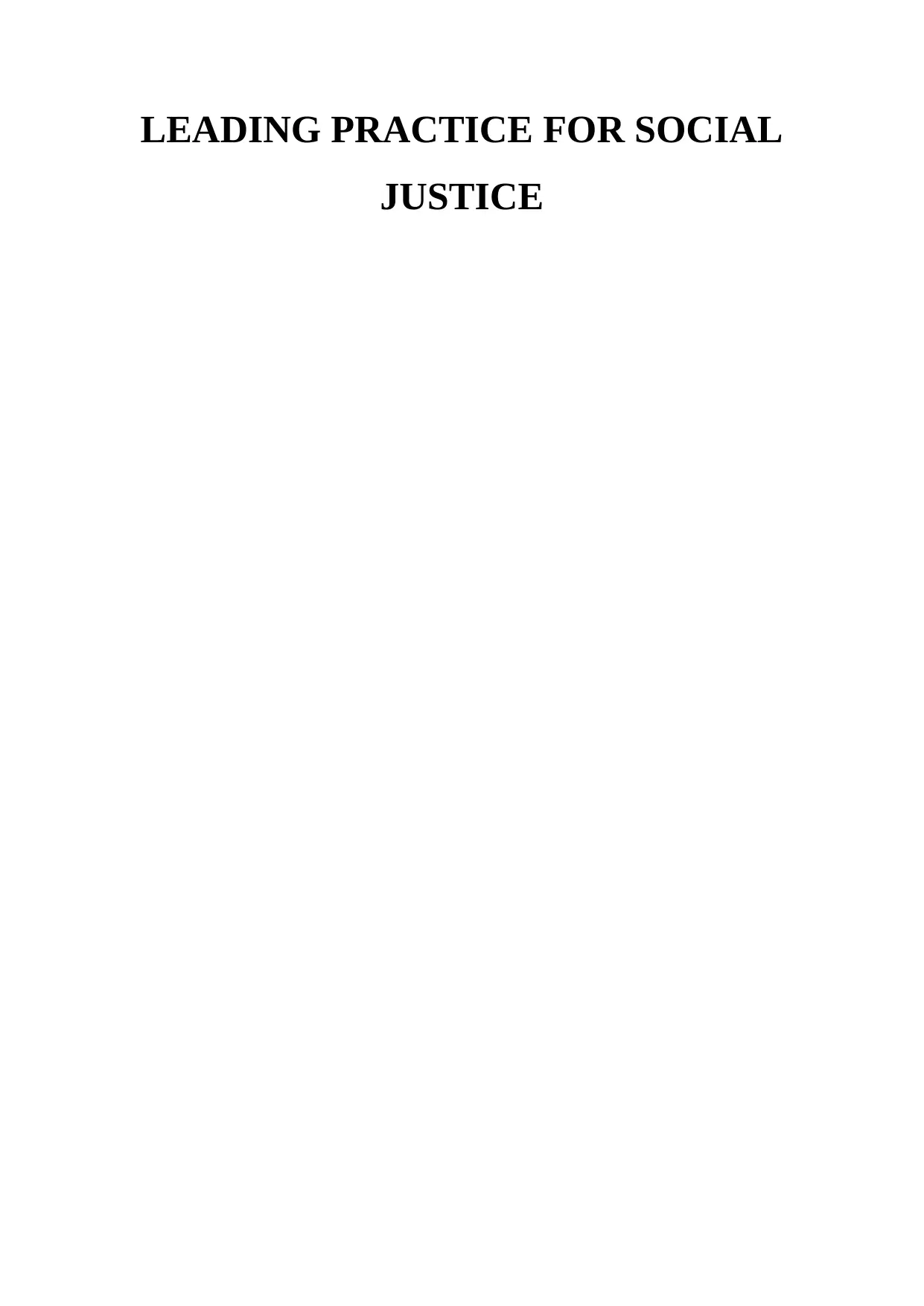
LEADING PRACTICE FOR SOCIAL
JUSTICE
JUSTICE
Paraphrase This Document
Need a fresh take? Get an instant paraphrase of this document with our AI Paraphraser
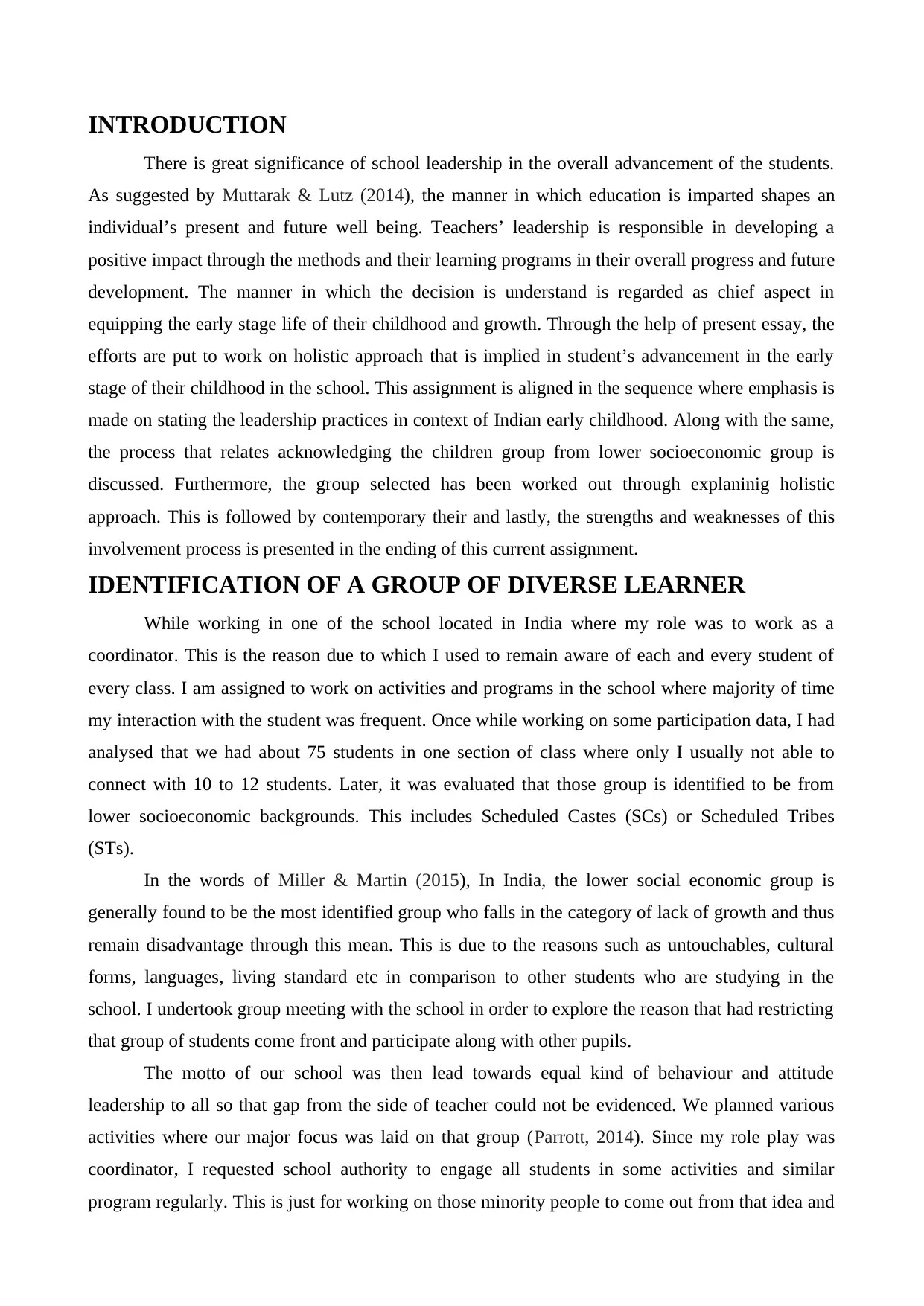
INTRODUCTION
There is great significance of school leadership in the overall advancement of the students.
As suggested by Muttarak & Lutz (2014), the manner in which education is imparted shapes an
individual’s present and future well being. Teachers’ leadership is responsible in developing a
positive impact through the methods and their learning programs in their overall progress and future
development. The manner in which the decision is understand is regarded as chief aspect in
equipping the early stage life of their childhood and growth. Through the help of present essay, the
efforts are put to work on holistic approach that is implied in student’s advancement in the early
stage of their childhood in the school. This assignment is aligned in the sequence where emphasis is
made on stating the leadership practices in context of Indian early childhood. Along with the same,
the process that relates acknowledging the children group from lower socioeconomic group is
discussed. Furthermore, the group selected has been worked out through explaninig holistic
approach. This is followed by contemporary their and lastly, the strengths and weaknesses of this
involvement process is presented in the ending of this current assignment.
IDENTIFICATION OF A GROUP OF DIVERSE LEARNER
While working in one of the school located in India where my role was to work as a
coordinator. This is the reason due to which I used to remain aware of each and every student of
every class. I am assigned to work on activities and programs in the school where majority of time
my interaction with the student was frequent. Once while working on some participation data, I had
analysed that we had about 75 students in one section of class where only I usually not able to
connect with 10 to 12 students. Later, it was evaluated that those group is identified to be from
lower socioeconomic backgrounds. This includes Scheduled Castes (SCs) or Scheduled Tribes
(STs).
In the words of Miller & Martin (2015), In India, the lower social economic group is
generally found to be the most identified group who falls in the category of lack of growth and thus
remain disadvantage through this mean. This is due to the reasons such as untouchables, cultural
forms, languages, living standard etc in comparison to other students who are studying in the
school. I undertook group meeting with the school in order to explore the reason that had restricting
that group of students come front and participate along with other pupils.
The motto of our school was then lead towards equal kind of behaviour and attitude
leadership to all so that gap from the side of teacher could not be evidenced. We planned various
activities where our major focus was laid on that group (Parrott, 2014). Since my role play was
coordinator, I requested school authority to engage all students in some activities and similar
program regularly. This is just for working on those minority people to come out from that idea and
There is great significance of school leadership in the overall advancement of the students.
As suggested by Muttarak & Lutz (2014), the manner in which education is imparted shapes an
individual’s present and future well being. Teachers’ leadership is responsible in developing a
positive impact through the methods and their learning programs in their overall progress and future
development. The manner in which the decision is understand is regarded as chief aspect in
equipping the early stage life of their childhood and growth. Through the help of present essay, the
efforts are put to work on holistic approach that is implied in student’s advancement in the early
stage of their childhood in the school. This assignment is aligned in the sequence where emphasis is
made on stating the leadership practices in context of Indian early childhood. Along with the same,
the process that relates acknowledging the children group from lower socioeconomic group is
discussed. Furthermore, the group selected has been worked out through explaninig holistic
approach. This is followed by contemporary their and lastly, the strengths and weaknesses of this
involvement process is presented in the ending of this current assignment.
IDENTIFICATION OF A GROUP OF DIVERSE LEARNER
While working in one of the school located in India where my role was to work as a
coordinator. This is the reason due to which I used to remain aware of each and every student of
every class. I am assigned to work on activities and programs in the school where majority of time
my interaction with the student was frequent. Once while working on some participation data, I had
analysed that we had about 75 students in one section of class where only I usually not able to
connect with 10 to 12 students. Later, it was evaluated that those group is identified to be from
lower socioeconomic backgrounds. This includes Scheduled Castes (SCs) or Scheduled Tribes
(STs).
In the words of Miller & Martin (2015), In India, the lower social economic group is
generally found to be the most identified group who falls in the category of lack of growth and thus
remain disadvantage through this mean. This is due to the reasons such as untouchables, cultural
forms, languages, living standard etc in comparison to other students who are studying in the
school. I undertook group meeting with the school in order to explore the reason that had restricting
that group of students come front and participate along with other pupils.
The motto of our school was then lead towards equal kind of behaviour and attitude
leadership to all so that gap from the side of teacher could not be evidenced. We planned various
activities where our major focus was laid on that group (Parrott, 2014). Since my role play was
coordinator, I requested school authority to engage all students in some activities and similar
program regularly. This is just for working on those minority people to come out from that idea and
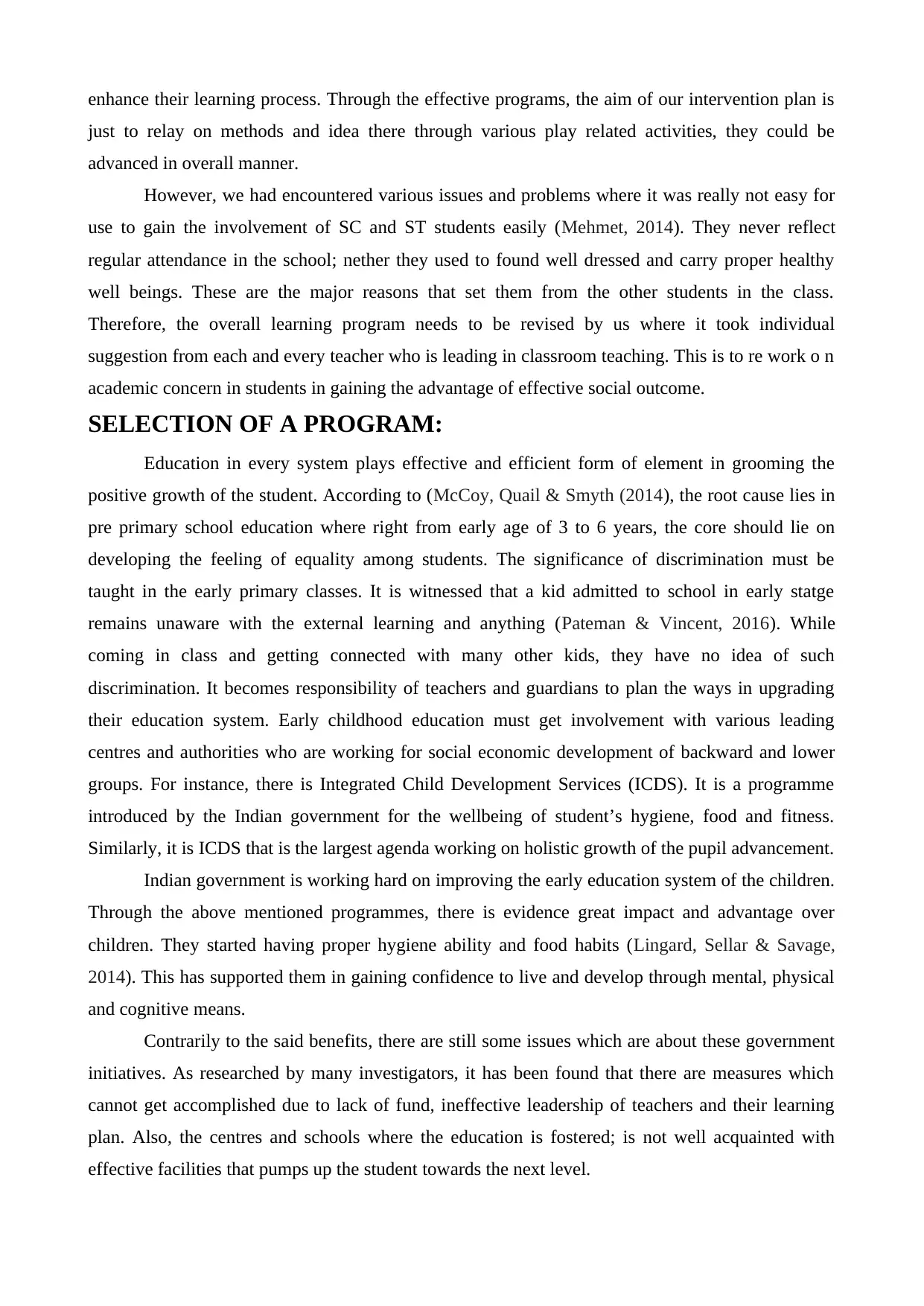
enhance their learning process. Through the effective programs, the aim of our intervention plan is
just to relay on methods and idea there through various play related activities, they could be
advanced in overall manner.
However, we had encountered various issues and problems where it was really not easy for
use to gain the involvement of SC and ST students easily (Mehmet, 2014). They never reflect
regular attendance in the school; nether they used to found well dressed and carry proper healthy
well beings. These are the major reasons that set them from the other students in the class.
Therefore, the overall learning program needs to be revised by us where it took individual
suggestion from each and every teacher who is leading in classroom teaching. This is to re work o n
academic concern in students in gaining the advantage of effective social outcome.
SELECTION OF A PROGRAM:
Education in every system plays effective and efficient form of element in grooming the
positive growth of the student. According to (McCoy, Quail & Smyth (2014), the root cause lies in
pre primary school education where right from early age of 3 to 6 years, the core should lie on
developing the feeling of equality among students. The significance of discrimination must be
taught in the early primary classes. It is witnessed that a kid admitted to school in early statge
remains unaware with the external learning and anything (Pateman & Vincent, 2016). While
coming in class and getting connected with many other kids, they have no idea of such
discrimination. It becomes responsibility of teachers and guardians to plan the ways in upgrading
their education system. Early childhood education must get involvement with various leading
centres and authorities who are working for social economic development of backward and lower
groups. For instance, there is Integrated Child Development Services (ICDS). It is a programme
introduced by the Indian government for the wellbeing of student’s hygiene, food and fitness.
Similarly, it is ICDS that is the largest agenda working on holistic growth of the pupil advancement.
Indian government is working hard on improving the early education system of the children.
Through the above mentioned programmes, there is evidence great impact and advantage over
children. They started having proper hygiene ability and food habits (Lingard, Sellar & Savage,
2014). This has supported them in gaining confidence to live and develop through mental, physical
and cognitive means.
Contrarily to the said benefits, there are still some issues which are about these government
initiatives. As researched by many investigators, it has been found that there are measures which
cannot get accomplished due to lack of fund, ineffective leadership of teachers and their learning
plan. Also, the centres and schools where the education is fostered; is not well acquainted with
effective facilities that pumps up the student towards the next level.
just to relay on methods and idea there through various play related activities, they could be
advanced in overall manner.
However, we had encountered various issues and problems where it was really not easy for
use to gain the involvement of SC and ST students easily (Mehmet, 2014). They never reflect
regular attendance in the school; nether they used to found well dressed and carry proper healthy
well beings. These are the major reasons that set them from the other students in the class.
Therefore, the overall learning program needs to be revised by us where it took individual
suggestion from each and every teacher who is leading in classroom teaching. This is to re work o n
academic concern in students in gaining the advantage of effective social outcome.
SELECTION OF A PROGRAM:
Education in every system plays effective and efficient form of element in grooming the
positive growth of the student. According to (McCoy, Quail & Smyth (2014), the root cause lies in
pre primary school education where right from early age of 3 to 6 years, the core should lie on
developing the feeling of equality among students. The significance of discrimination must be
taught in the early primary classes. It is witnessed that a kid admitted to school in early statge
remains unaware with the external learning and anything (Pateman & Vincent, 2016). While
coming in class and getting connected with many other kids, they have no idea of such
discrimination. It becomes responsibility of teachers and guardians to plan the ways in upgrading
their education system. Early childhood education must get involvement with various leading
centres and authorities who are working for social economic development of backward and lower
groups. For instance, there is Integrated Child Development Services (ICDS). It is a programme
introduced by the Indian government for the wellbeing of student’s hygiene, food and fitness.
Similarly, it is ICDS that is the largest agenda working on holistic growth of the pupil advancement.
Indian government is working hard on improving the early education system of the children.
Through the above mentioned programmes, there is evidence great impact and advantage over
children. They started having proper hygiene ability and food habits (Lingard, Sellar & Savage,
2014). This has supported them in gaining confidence to live and develop through mental, physical
and cognitive means.
Contrarily to the said benefits, there are still some issues which are about these government
initiatives. As researched by many investigators, it has been found that there are measures which
cannot get accomplished due to lack of fund, ineffective leadership of teachers and their learning
plan. Also, the centres and schools where the education is fostered; is not well acquainted with
effective facilities that pumps up the student towards the next level.
⊘ This is a preview!⊘
Do you want full access?
Subscribe today to unlock all pages.

Trusted by 1+ million students worldwide
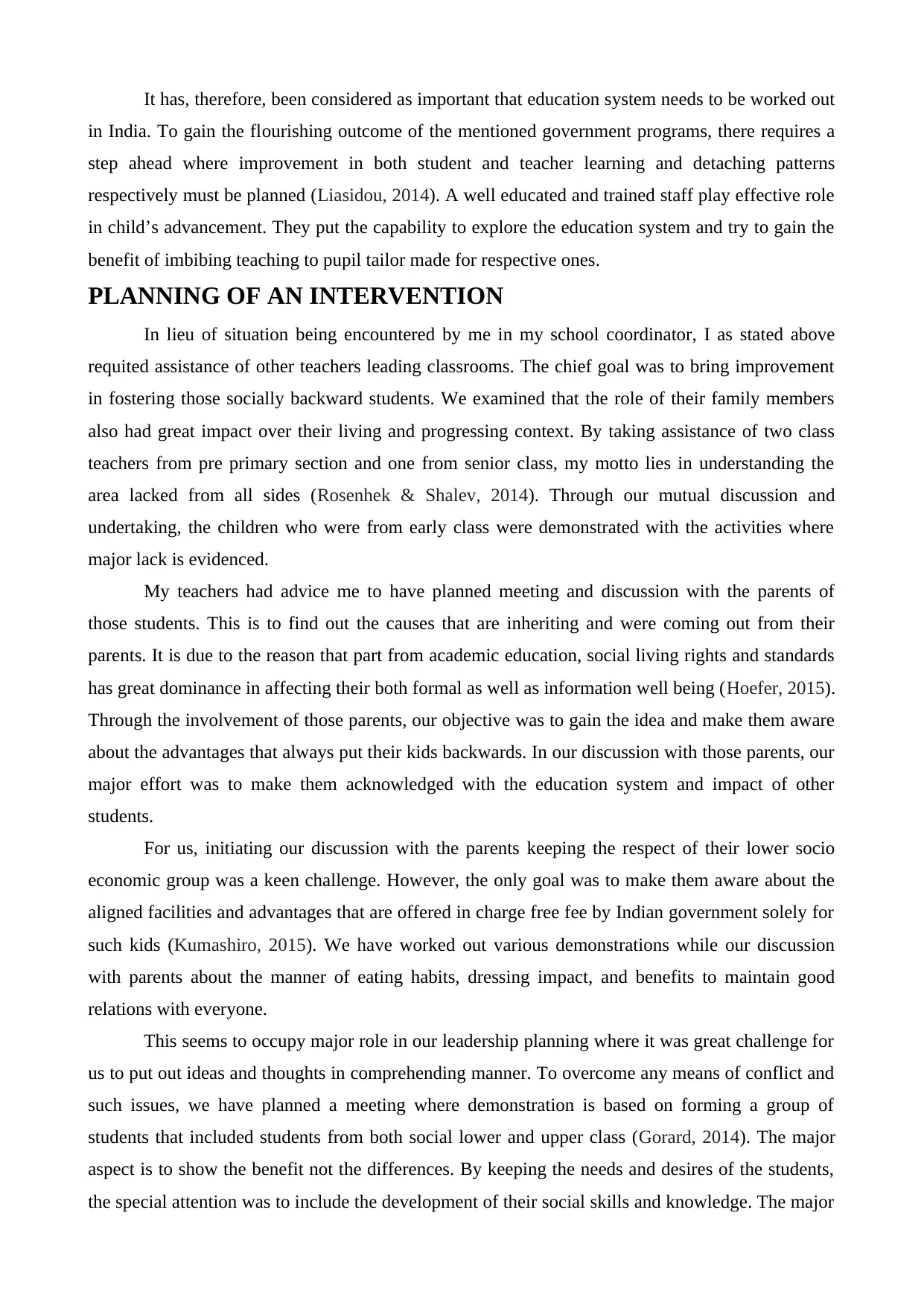
It has, therefore, been considered as important that education system needs to be worked out
in India. To gain the flourishing outcome of the mentioned government programs, there requires a
step ahead where improvement in both student and teacher learning and detaching patterns
respectively must be planned (Liasidou, 2014). A well educated and trained staff play effective role
in child’s advancement. They put the capability to explore the education system and try to gain the
benefit of imbibing teaching to pupil tailor made for respective ones.
PLANNING OF AN INTERVENTION
In lieu of situation being encountered by me in my school coordinator, I as stated above
requited assistance of other teachers leading classrooms. The chief goal was to bring improvement
in fostering those socially backward students. We examined that the role of their family members
also had great impact over their living and progressing context. By taking assistance of two class
teachers from pre primary section and one from senior class, my motto lies in understanding the
area lacked from all sides (Rosenhek & Shalev, 2014). Through our mutual discussion and
undertaking, the children who were from early class were demonstrated with the activities where
major lack is evidenced.
My teachers had advice me to have planned meeting and discussion with the parents of
those students. This is to find out the causes that are inheriting and were coming out from their
parents. It is due to the reason that part from academic education, social living rights and standards
has great dominance in affecting their both formal as well as information well being (Hoefer, 2015).
Through the involvement of those parents, our objective was to gain the idea and make them aware
about the advantages that always put their kids backwards. In our discussion with those parents, our
major effort was to make them acknowledged with the education system and impact of other
students.
For us, initiating our discussion with the parents keeping the respect of their lower socio
economic group was a keen challenge. However, the only goal was to make them aware about the
aligned facilities and advantages that are offered in charge free fee by Indian government solely for
such kids (Kumashiro, 2015). We have worked out various demonstrations while our discussion
with parents about the manner of eating habits, dressing impact, and benefits to maintain good
relations with everyone.
This seems to occupy major role in our leadership planning where it was great challenge for
us to put out ideas and thoughts in comprehending manner. To overcome any means of conflict and
such issues, we have planned a meeting where demonstration is based on forming a group of
students that included students from both social lower and upper class (Gorard, 2014). The major
aspect is to show the benefit not the differences. By keeping the needs and desires of the students,
the special attention was to include the development of their social skills and knowledge. The major
in India. To gain the flourishing outcome of the mentioned government programs, there requires a
step ahead where improvement in both student and teacher learning and detaching patterns
respectively must be planned (Liasidou, 2014). A well educated and trained staff play effective role
in child’s advancement. They put the capability to explore the education system and try to gain the
benefit of imbibing teaching to pupil tailor made for respective ones.
PLANNING OF AN INTERVENTION
In lieu of situation being encountered by me in my school coordinator, I as stated above
requited assistance of other teachers leading classrooms. The chief goal was to bring improvement
in fostering those socially backward students. We examined that the role of their family members
also had great impact over their living and progressing context. By taking assistance of two class
teachers from pre primary section and one from senior class, my motto lies in understanding the
area lacked from all sides (Rosenhek & Shalev, 2014). Through our mutual discussion and
undertaking, the children who were from early class were demonstrated with the activities where
major lack is evidenced.
My teachers had advice me to have planned meeting and discussion with the parents of
those students. This is to find out the causes that are inheriting and were coming out from their
parents. It is due to the reason that part from academic education, social living rights and standards
has great dominance in affecting their both formal as well as information well being (Hoefer, 2015).
Through the involvement of those parents, our objective was to gain the idea and make them aware
about the advantages that always put their kids backwards. In our discussion with those parents, our
major effort was to make them acknowledged with the education system and impact of other
students.
For us, initiating our discussion with the parents keeping the respect of their lower socio
economic group was a keen challenge. However, the only goal was to make them aware about the
aligned facilities and advantages that are offered in charge free fee by Indian government solely for
such kids (Kumashiro, 2015). We have worked out various demonstrations while our discussion
with parents about the manner of eating habits, dressing impact, and benefits to maintain good
relations with everyone.
This seems to occupy major role in our leadership planning where it was great challenge for
us to put out ideas and thoughts in comprehending manner. To overcome any means of conflict and
such issues, we have planned a meeting where demonstration is based on forming a group of
students that included students from both social lower and upper class (Gorard, 2014). The major
aspect is to show the benefit not the differences. By keeping the needs and desires of the students,
the special attention was to include the development of their social skills and knowledge. The major
Paraphrase This Document
Need a fresh take? Get an instant paraphrase of this document with our AI Paraphraser
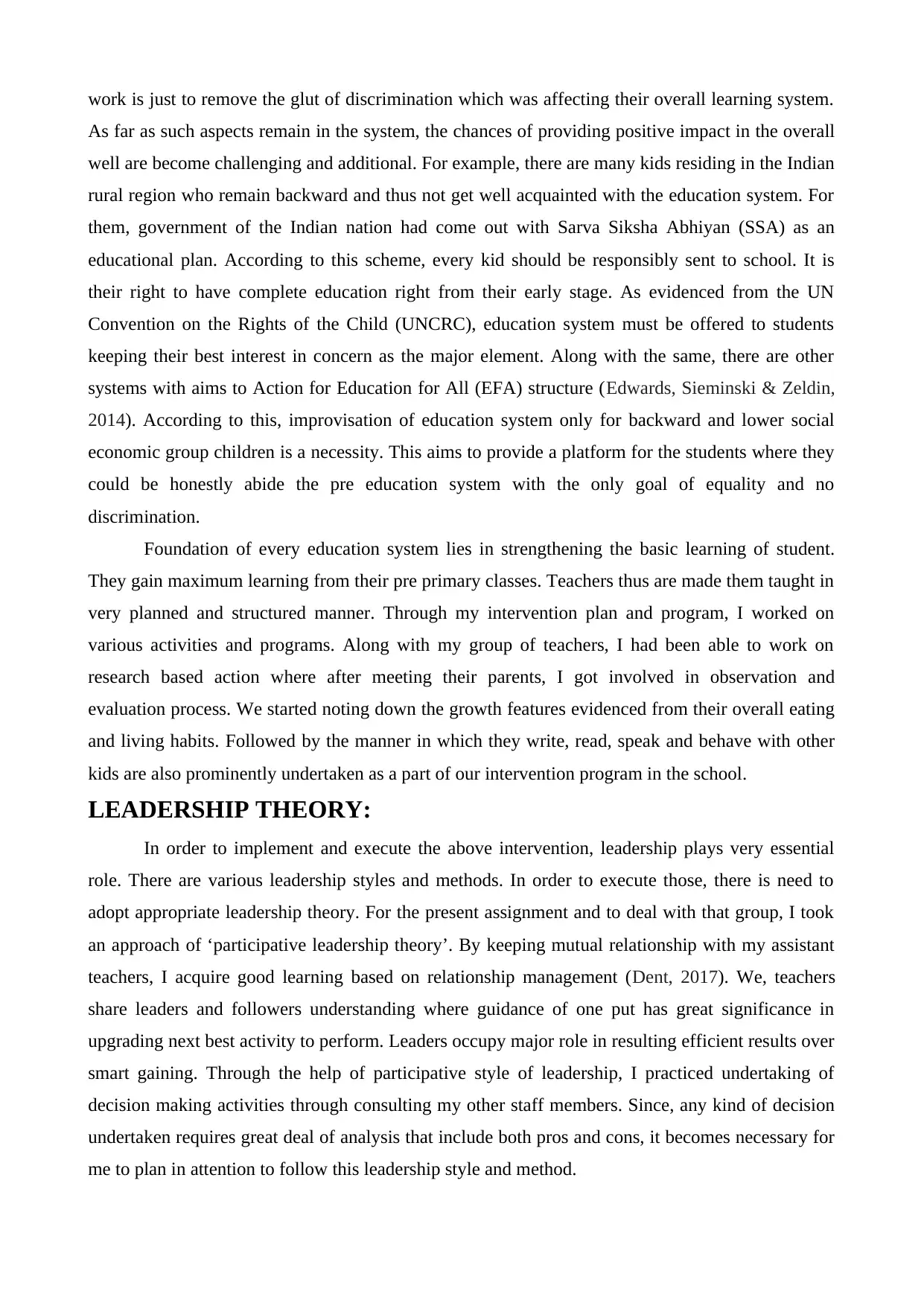
work is just to remove the glut of discrimination which was affecting their overall learning system.
As far as such aspects remain in the system, the chances of providing positive impact in the overall
well are become challenging and additional. For example, there are many kids residing in the Indian
rural region who remain backward and thus not get well acquainted with the education system. For
them, government of the Indian nation had come out with Sarva Siksha Abhiyan (SSA) as an
educational plan. According to this scheme, every kid should be responsibly sent to school. It is
their right to have complete education right from their early stage. As evidenced from the UN
Convention on the Rights of the Child (UNCRC), education system must be offered to students
keeping their best interest in concern as the major element. Along with the same, there are other
systems with aims to Action for Education for All (EFA) structure (Edwards, Sieminski & Zeldin,
2014). According to this, improvisation of education system only for backward and lower social
economic group children is a necessity. This aims to provide a platform for the students where they
could be honestly abide the pre education system with the only goal of equality and no
discrimination.
Foundation of every education system lies in strengthening the basic learning of student.
They gain maximum learning from their pre primary classes. Teachers thus are made them taught in
very planned and structured manner. Through my intervention plan and program, I worked on
various activities and programs. Along with my group of teachers, I had been able to work on
research based action where after meeting their parents, I got involved in observation and
evaluation process. We started noting down the growth features evidenced from their overall eating
and living habits. Followed by the manner in which they write, read, speak and behave with other
kids are also prominently undertaken as a part of our intervention program in the school.
LEADERSHIP THEORY:
In order to implement and execute the above intervention, leadership plays very essential
role. There are various leadership styles and methods. In order to execute those, there is need to
adopt appropriate leadership theory. For the present assignment and to deal with that group, I took
an approach of ‘participative leadership theory’. By keeping mutual relationship with my assistant
teachers, I acquire good learning based on relationship management (Dent, 2017). We, teachers
share leaders and followers understanding where guidance of one put has great significance in
upgrading next best activity to perform. Leaders occupy major role in resulting efficient results over
smart gaining. Through the help of participative style of leadership, I practiced undertaking of
decision making activities through consulting my other staff members. Since, any kind of decision
undertaken requires great deal of analysis that include both pros and cons, it becomes necessary for
me to plan in attention to follow this leadership style and method.
As far as such aspects remain in the system, the chances of providing positive impact in the overall
well are become challenging and additional. For example, there are many kids residing in the Indian
rural region who remain backward and thus not get well acquainted with the education system. For
them, government of the Indian nation had come out with Sarva Siksha Abhiyan (SSA) as an
educational plan. According to this scheme, every kid should be responsibly sent to school. It is
their right to have complete education right from their early stage. As evidenced from the UN
Convention on the Rights of the Child (UNCRC), education system must be offered to students
keeping their best interest in concern as the major element. Along with the same, there are other
systems with aims to Action for Education for All (EFA) structure (Edwards, Sieminski & Zeldin,
2014). According to this, improvisation of education system only for backward and lower social
economic group children is a necessity. This aims to provide a platform for the students where they
could be honestly abide the pre education system with the only goal of equality and no
discrimination.
Foundation of every education system lies in strengthening the basic learning of student.
They gain maximum learning from their pre primary classes. Teachers thus are made them taught in
very planned and structured manner. Through my intervention plan and program, I worked on
various activities and programs. Along with my group of teachers, I had been able to work on
research based action where after meeting their parents, I got involved in observation and
evaluation process. We started noting down the growth features evidenced from their overall eating
and living habits. Followed by the manner in which they write, read, speak and behave with other
kids are also prominently undertaken as a part of our intervention program in the school.
LEADERSHIP THEORY:
In order to implement and execute the above intervention, leadership plays very essential
role. There are various leadership styles and methods. In order to execute those, there is need to
adopt appropriate leadership theory. For the present assignment and to deal with that group, I took
an approach of ‘participative leadership theory’. By keeping mutual relationship with my assistant
teachers, I acquire good learning based on relationship management (Dent, 2017). We, teachers
share leaders and followers understanding where guidance of one put has great significance in
upgrading next best activity to perform. Leaders occupy major role in resulting efficient results over
smart gaining. Through the help of participative style of leadership, I practiced undertaking of
decision making activities through consulting my other staff members. Since, any kind of decision
undertaken requires great deal of analysis that include both pros and cons, it becomes necessary for
me to plan in attention to follow this leadership style and method.
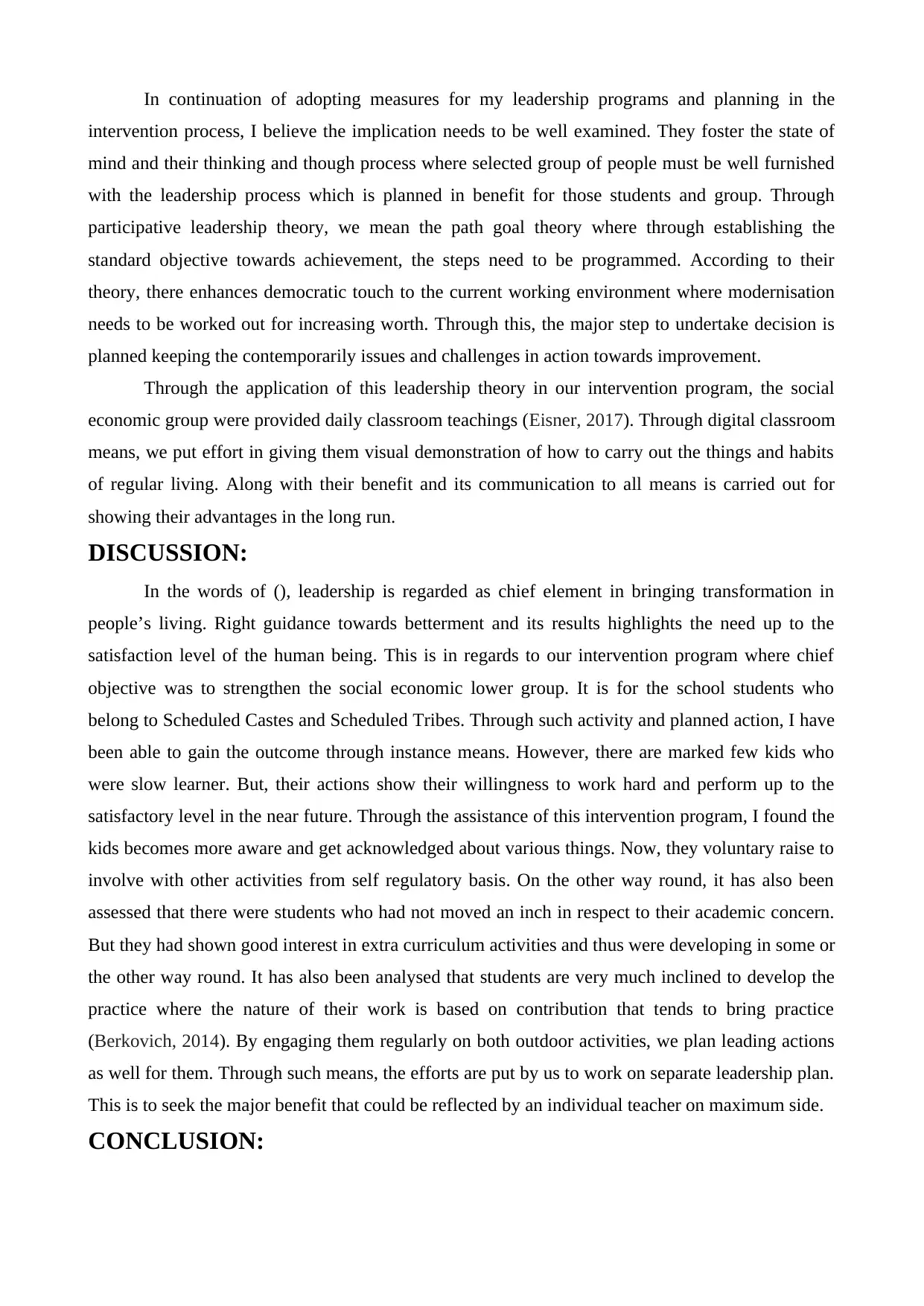
In continuation of adopting measures for my leadership programs and planning in the
intervention process, I believe the implication needs to be well examined. They foster the state of
mind and their thinking and though process where selected group of people must be well furnished
with the leadership process which is planned in benefit for those students and group. Through
participative leadership theory, we mean the path goal theory where through establishing the
standard objective towards achievement, the steps need to be programmed. According to their
theory, there enhances democratic touch to the current working environment where modernisation
needs to be worked out for increasing worth. Through this, the major step to undertake decision is
planned keeping the contemporarily issues and challenges in action towards improvement.
Through the application of this leadership theory in our intervention program, the social
economic group were provided daily classroom teachings (Eisner, 2017). Through digital classroom
means, we put effort in giving them visual demonstration of how to carry out the things and habits
of regular living. Along with their benefit and its communication to all means is carried out for
showing their advantages in the long run.
DISCUSSION:
In the words of (), leadership is regarded as chief element in bringing transformation in
people’s living. Right guidance towards betterment and its results highlights the need up to the
satisfaction level of the human being. This is in regards to our intervention program where chief
objective was to strengthen the social economic lower group. It is for the school students who
belong to Scheduled Castes and Scheduled Tribes. Through such activity and planned action, I have
been able to gain the outcome through instance means. However, there are marked few kids who
were slow learner. But, their actions show their willingness to work hard and perform up to the
satisfactory level in the near future. Through the assistance of this intervention program, I found the
kids becomes more aware and get acknowledged about various things. Now, they voluntary raise to
involve with other activities from self regulatory basis. On the other way round, it has also been
assessed that there were students who had not moved an inch in respect to their academic concern.
But they had shown good interest in extra curriculum activities and thus were developing in some or
the other way round. It has also been analysed that students are very much inclined to develop the
practice where the nature of their work is based on contribution that tends to bring practice
(Berkovich, 2014). By engaging them regularly on both outdoor activities, we plan leading actions
as well for them. Through such means, the efforts are put by us to work on separate leadership plan.
This is to seek the major benefit that could be reflected by an individual teacher on maximum side.
CONCLUSION:
intervention process, I believe the implication needs to be well examined. They foster the state of
mind and their thinking and though process where selected group of people must be well furnished
with the leadership process which is planned in benefit for those students and group. Through
participative leadership theory, we mean the path goal theory where through establishing the
standard objective towards achievement, the steps need to be programmed. According to their
theory, there enhances democratic touch to the current working environment where modernisation
needs to be worked out for increasing worth. Through this, the major step to undertake decision is
planned keeping the contemporarily issues and challenges in action towards improvement.
Through the application of this leadership theory in our intervention program, the social
economic group were provided daily classroom teachings (Eisner, 2017). Through digital classroom
means, we put effort in giving them visual demonstration of how to carry out the things and habits
of regular living. Along with their benefit and its communication to all means is carried out for
showing their advantages in the long run.
DISCUSSION:
In the words of (), leadership is regarded as chief element in bringing transformation in
people’s living. Right guidance towards betterment and its results highlights the need up to the
satisfaction level of the human being. This is in regards to our intervention program where chief
objective was to strengthen the social economic lower group. It is for the school students who
belong to Scheduled Castes and Scheduled Tribes. Through such activity and planned action, I have
been able to gain the outcome through instance means. However, there are marked few kids who
were slow learner. But, their actions show their willingness to work hard and perform up to the
satisfactory level in the near future. Through the assistance of this intervention program, I found the
kids becomes more aware and get acknowledged about various things. Now, they voluntary raise to
involve with other activities from self regulatory basis. On the other way round, it has also been
assessed that there were students who had not moved an inch in respect to their academic concern.
But they had shown good interest in extra curriculum activities and thus were developing in some or
the other way round. It has also been analysed that students are very much inclined to develop the
practice where the nature of their work is based on contribution that tends to bring practice
(Berkovich, 2014). By engaging them regularly on both outdoor activities, we plan leading actions
as well for them. Through such means, the efforts are put by us to work on separate leadership plan.
This is to seek the major benefit that could be reflected by an individual teacher on maximum side.
CONCLUSION:
⊘ This is a preview!⊘
Do you want full access?
Subscribe today to unlock all pages.

Trusted by 1+ million students worldwide
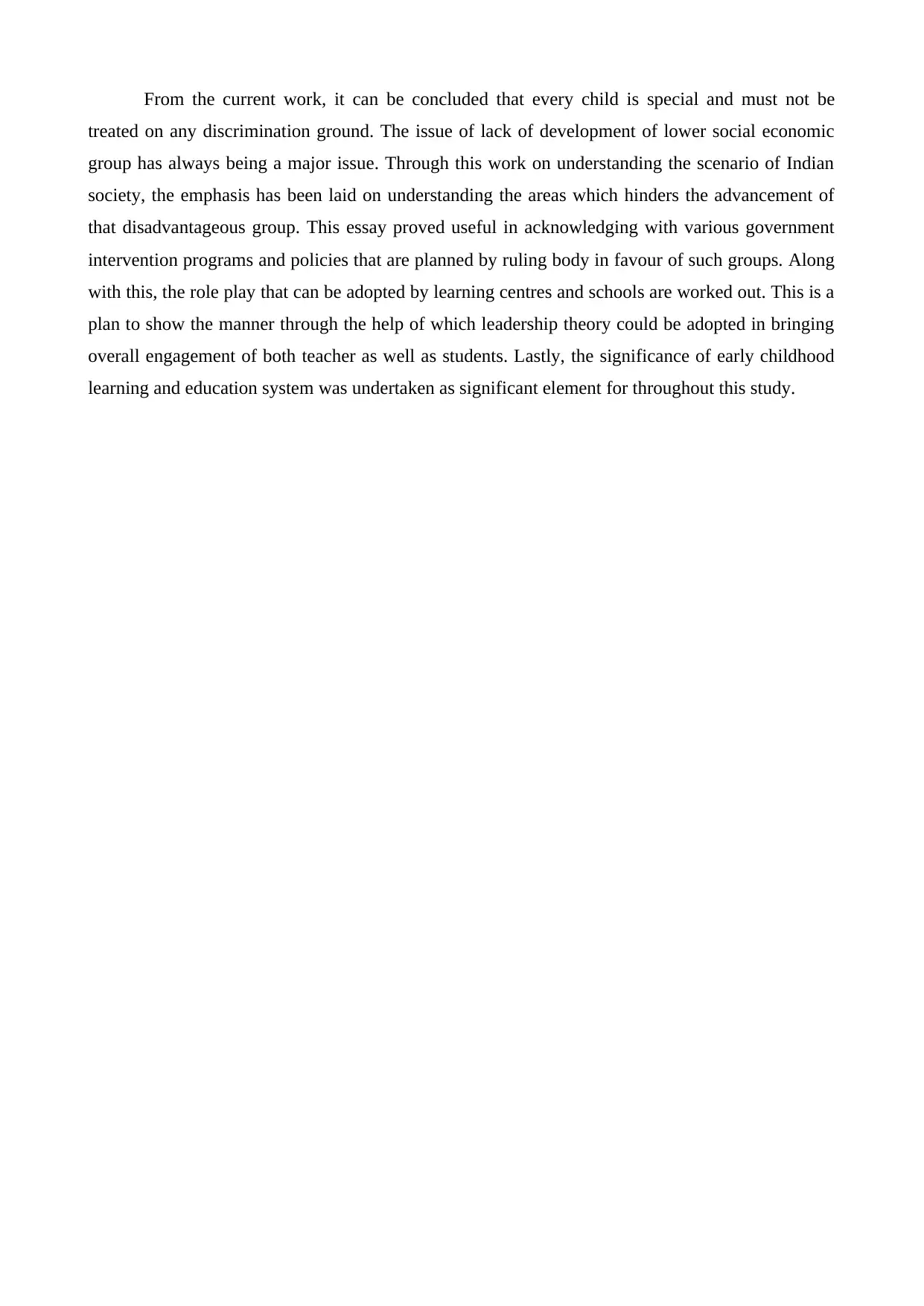
From the current work, it can be concluded that every child is special and must not be
treated on any discrimination ground. The issue of lack of development of lower social economic
group has always being a major issue. Through this work on understanding the scenario of Indian
society, the emphasis has been laid on understanding the areas which hinders the advancement of
that disadvantageous group. This essay proved useful in acknowledging with various government
intervention programs and policies that are planned by ruling body in favour of such groups. Along
with this, the role play that can be adopted by learning centres and schools are worked out. This is a
plan to show the manner through the help of which leadership theory could be adopted in bringing
overall engagement of both teacher as well as students. Lastly, the significance of early childhood
learning and education system was undertaken as significant element for throughout this study.
treated on any discrimination ground. The issue of lack of development of lower social economic
group has always being a major issue. Through this work on understanding the scenario of Indian
society, the emphasis has been laid on understanding the areas which hinders the advancement of
that disadvantageous group. This essay proved useful in acknowledging with various government
intervention programs and policies that are planned by ruling body in favour of such groups. Along
with this, the role play that can be adopted by learning centres and schools are worked out. This is a
plan to show the manner through the help of which leadership theory could be adopted in bringing
overall engagement of both teacher as well as students. Lastly, the significance of early childhood
learning and education system was undertaken as significant element for throughout this study.
Paraphrase This Document
Need a fresh take? Get an instant paraphrase of this document with our AI Paraphraser
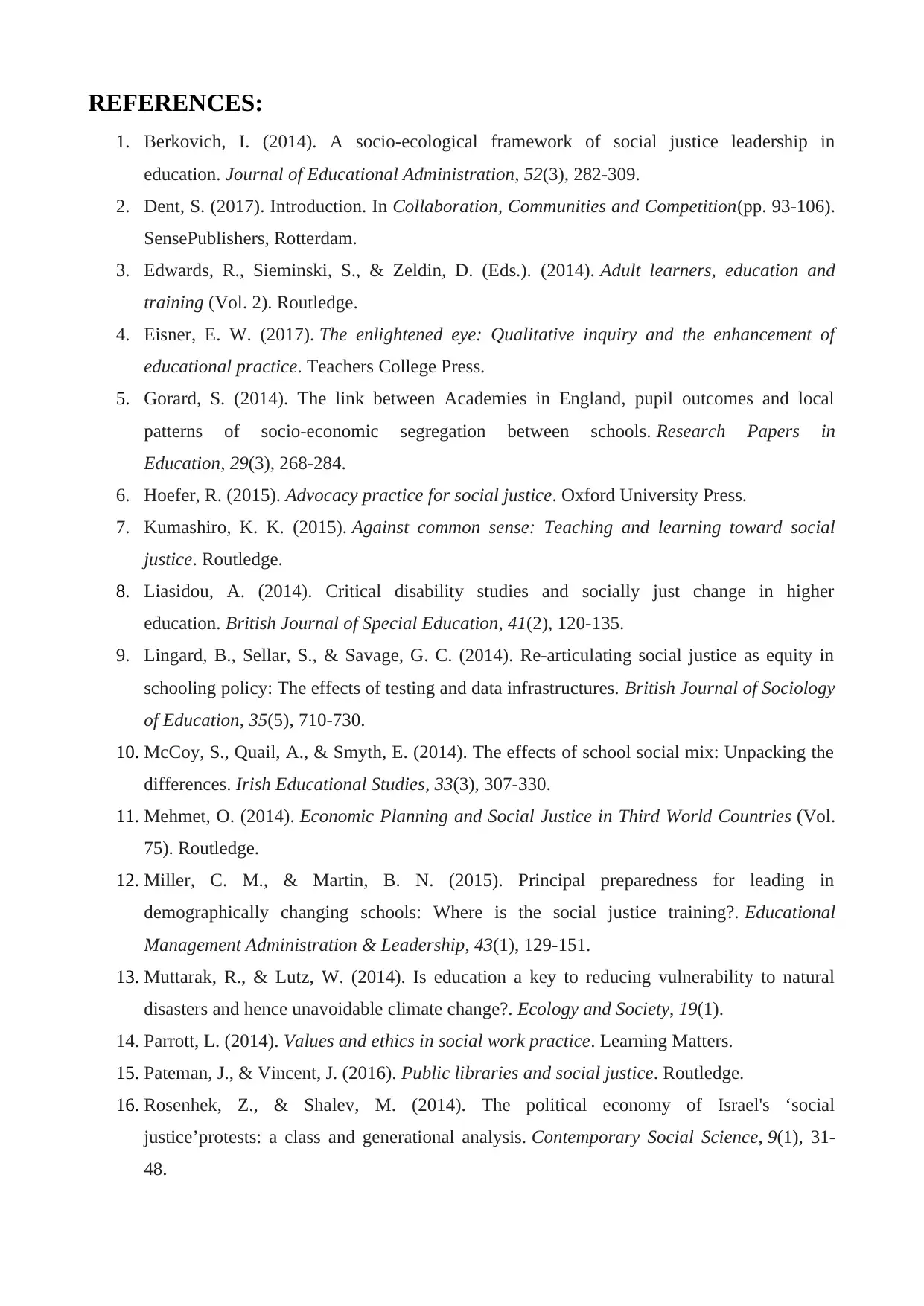
REFERENCES:
1. Berkovich, I. (2014). A socio-ecological framework of social justice leadership in
education. Journal of Educational Administration, 52(3), 282-309.
2. Dent, S. (2017). Introduction. In Collaboration, Communities and Competition(pp. 93-106).
SensePublishers, Rotterdam.
3. Edwards, R., Sieminski, S., & Zeldin, D. (Eds.). (2014). Adult learners, education and
training (Vol. 2). Routledge.
4. Eisner, E. W. (2017). The enlightened eye: Qualitative inquiry and the enhancement of
educational practice. Teachers College Press.
5. Gorard, S. (2014). The link between Academies in England, pupil outcomes and local
patterns of socio-economic segregation between schools. Research Papers in
Education, 29(3), 268-284.
6. Hoefer, R. (2015). Advocacy practice for social justice. Oxford University Press.
7. Kumashiro, K. K. (2015). Against common sense: Teaching and learning toward social
justice. Routledge.
8. Liasidou, A. (2014). Critical disability studies and socially just change in higher
education. British Journal of Special Education, 41(2), 120-135.
9. Lingard, B., Sellar, S., & Savage, G. C. (2014). Re-articulating social justice as equity in
schooling policy: The effects of testing and data infrastructures. British Journal of Sociology
of Education, 35(5), 710-730.
10. McCoy, S., Quail, A., & Smyth, E. (2014). The effects of school social mix: Unpacking the
differences. Irish Educational Studies, 33(3), 307-330.
11. Mehmet, O. (2014). Economic Planning and Social Justice in Third World Countries (Vol.
75). Routledge.
12. Miller, C. M., & Martin, B. N. (2015). Principal preparedness for leading in
demographically changing schools: Where is the social justice training?. Educational
Management Administration & Leadership, 43(1), 129-151.
13. Muttarak, R., & Lutz, W. (2014). Is education a key to reducing vulnerability to natural
disasters and hence unavoidable climate change?. Ecology and Society, 19(1).
14. Parrott, L. (2014). Values and ethics in social work practice. Learning Matters.
15. Pateman, J., & Vincent, J. (2016). Public libraries and social justice. Routledge.
16. Rosenhek, Z., & Shalev, M. (2014). The political economy of Israel's ‘social
justice’protests: a class and generational analysis. Contemporary Social Science, 9(1), 31-
48.
1. Berkovich, I. (2014). A socio-ecological framework of social justice leadership in
education. Journal of Educational Administration, 52(3), 282-309.
2. Dent, S. (2017). Introduction. In Collaboration, Communities and Competition(pp. 93-106).
SensePublishers, Rotterdam.
3. Edwards, R., Sieminski, S., & Zeldin, D. (Eds.). (2014). Adult learners, education and
training (Vol. 2). Routledge.
4. Eisner, E. W. (2017). The enlightened eye: Qualitative inquiry and the enhancement of
educational practice. Teachers College Press.
5. Gorard, S. (2014). The link between Academies in England, pupil outcomes and local
patterns of socio-economic segregation between schools. Research Papers in
Education, 29(3), 268-284.
6. Hoefer, R. (2015). Advocacy practice for social justice. Oxford University Press.
7. Kumashiro, K. K. (2015). Against common sense: Teaching and learning toward social
justice. Routledge.
8. Liasidou, A. (2014). Critical disability studies and socially just change in higher
education. British Journal of Special Education, 41(2), 120-135.
9. Lingard, B., Sellar, S., & Savage, G. C. (2014). Re-articulating social justice as equity in
schooling policy: The effects of testing and data infrastructures. British Journal of Sociology
of Education, 35(5), 710-730.
10. McCoy, S., Quail, A., & Smyth, E. (2014). The effects of school social mix: Unpacking the
differences. Irish Educational Studies, 33(3), 307-330.
11. Mehmet, O. (2014). Economic Planning and Social Justice in Third World Countries (Vol.
75). Routledge.
12. Miller, C. M., & Martin, B. N. (2015). Principal preparedness for leading in
demographically changing schools: Where is the social justice training?. Educational
Management Administration & Leadership, 43(1), 129-151.
13. Muttarak, R., & Lutz, W. (2014). Is education a key to reducing vulnerability to natural
disasters and hence unavoidable climate change?. Ecology and Society, 19(1).
14. Parrott, L. (2014). Values and ethics in social work practice. Learning Matters.
15. Pateman, J., & Vincent, J. (2016). Public libraries and social justice. Routledge.
16. Rosenhek, Z., & Shalev, M. (2014). The political economy of Israel's ‘social
justice’protests: a class and generational analysis. Contemporary Social Science, 9(1), 31-
48.
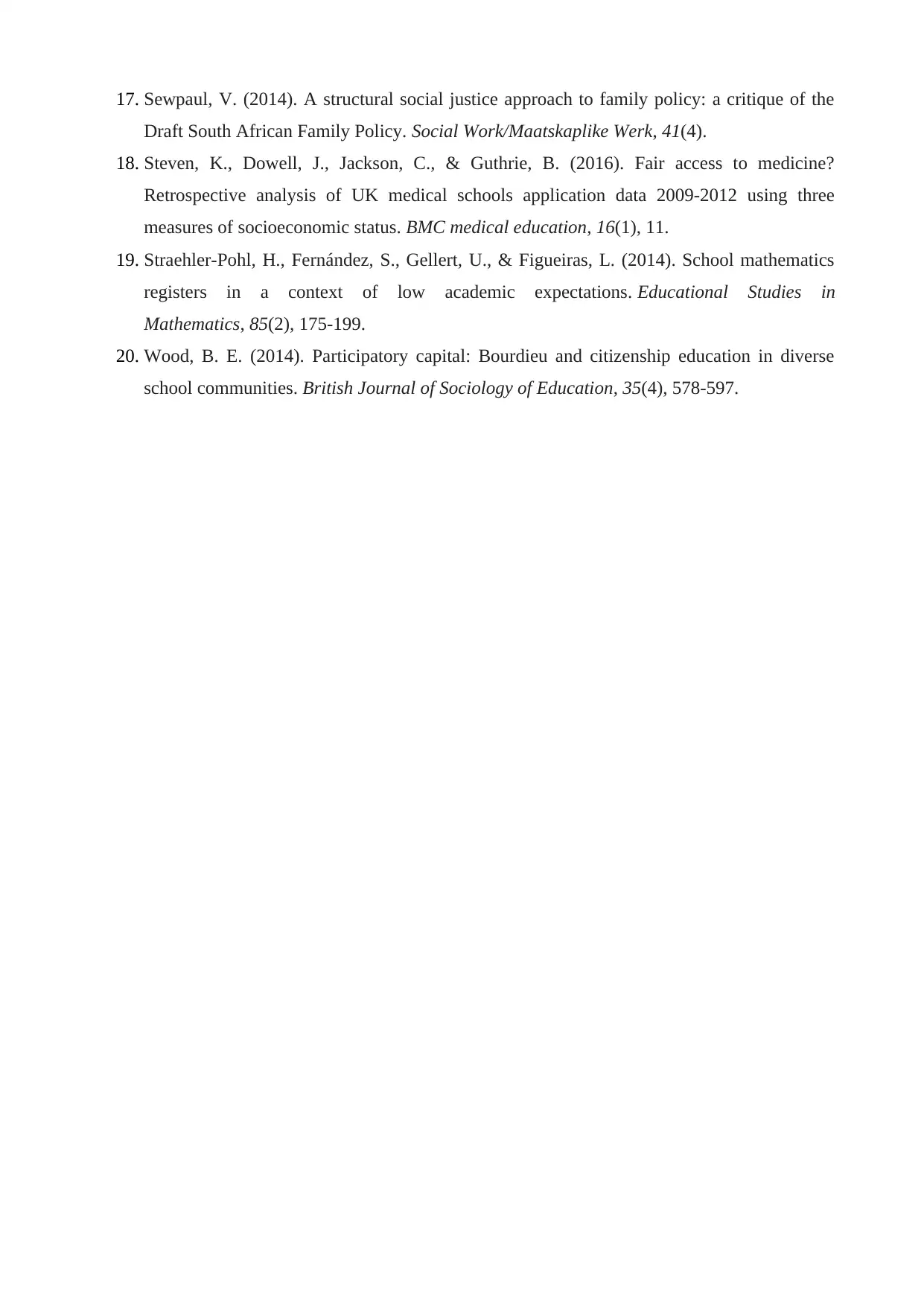
17. Sewpaul, V. (2014). A structural social justice approach to family policy: a critique of the
Draft South African Family Policy. Social Work/Maatskaplike Werk, 41(4).
18. Steven, K., Dowell, J., Jackson, C., & Guthrie, B. (2016). Fair access to medicine?
Retrospective analysis of UK medical schools application data 2009-2012 using three
measures of socioeconomic status. BMC medical education, 16(1), 11.
19. Straehler-Pohl, H., Fernández, S., Gellert, U., & Figueiras, L. (2014). School mathematics
registers in a context of low academic expectations. Educational Studies in
Mathematics, 85(2), 175-199.
20. Wood, B. E. (2014). Participatory capital: Bourdieu and citizenship education in diverse
school communities. British Journal of Sociology of Education, 35(4), 578-597.
Draft South African Family Policy. Social Work/Maatskaplike Werk, 41(4).
18. Steven, K., Dowell, J., Jackson, C., & Guthrie, B. (2016). Fair access to medicine?
Retrospective analysis of UK medical schools application data 2009-2012 using three
measures of socioeconomic status. BMC medical education, 16(1), 11.
19. Straehler-Pohl, H., Fernández, S., Gellert, U., & Figueiras, L. (2014). School mathematics
registers in a context of low academic expectations. Educational Studies in
Mathematics, 85(2), 175-199.
20. Wood, B. E. (2014). Participatory capital: Bourdieu and citizenship education in diverse
school communities. British Journal of Sociology of Education, 35(4), 578-597.
⊘ This is a preview!⊘
Do you want full access?
Subscribe today to unlock all pages.

Trusted by 1+ million students worldwide
1 out of 9
Related Documents
Your All-in-One AI-Powered Toolkit for Academic Success.
+13062052269
info@desklib.com
Available 24*7 on WhatsApp / Email
![[object Object]](/_next/static/media/star-bottom.7253800d.svg)
Unlock your academic potential
Copyright © 2020–2025 A2Z Services. All Rights Reserved. Developed and managed by ZUCOL.





